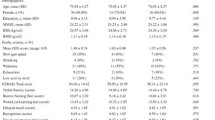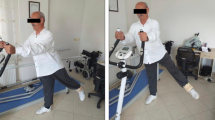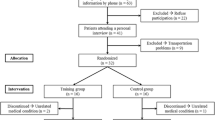Abstract
Background
Physical frailty and impaired executive function of the brain show similar pathophysiology. Both of these factors lead to dysfunction of neuromuscular and abilities in elderly. Highspeed power training (HSPT) has been determined to have positive effects on neuromuscular function and gait performance, as well as executive function in the elderly.
Objectives
The purpose of this study was to investigate the effects of 8-week HSPT on neuromuscular, gait and executive functions in frail elderly with mild cognitive impairment (MCI). Design, setting and participants: We performed a randomized controlled trial of frail elderly from community and medical center in republic of Korea. Forty-two physically frail elderly with MCI were randomly allocated to control (n=22, age=74.22±4.46) and intervention groups (n=18, age=73.77±4.64). The intervention group was subjected to HSPT, 3 times weekly for 8 weeks.
Measurements
Isometric contraction of knee extension and flexion with electromyography (EMG) was measured to determine the neuromuscular function such as knee extensor strength, rate of torque development, movement time, pre-motor time, motor time, rate of EMG rise, and hamstrings antagonist co-activation. Additionally, the 4.44-meter gait and timed up-and-go (TUG) test were administered to assess gait performance. A frontal assessment battery was measured in this study.
Results
The 8-week HSPT regimen improved the knee extensor strength from 1.13±0.08 to 1.25±0.07 (p<0.05), the 200-ms RTD from 3.01±0.3 to 3.55±0.24 (p<0.05) and the rate of EMG rise from 166.48±13.31 to 197.94±11.51 (p<0.05), whereas the movement time and motor time were statistically decreased from 921.69±40.10 to 799.51±72.84, and 271.40±19.29 to 181.15±38.08 (p<0.05), respectively. The 4.44-m gait speed and TUG significantly decreased from 6.39±0.25 to 5.5±0.24, and 11.05±0.53 to 9.17±0.43 respectively (p<0.05).
Conclusion
The findings of this study suggest the favorable effects of 8-week HSPT on the neuromuscular function and the gait performance in the frail elderly with MCI without increase in the executive function.



Similar content being viewed by others
References
Fried LP, Tangen CM, Walston J, et al. Frailty in older adults: evidence for a phenotype. J Gerontol A Biol Sci Med Sci 2001;56(3):M146–56.
LaRoche DP, Roy SJ, Knight CA, Dickie JL. Elderly women have blunted response to resistance training despite reduced antagonist coactivation. Med Sci Sports Exerc 2008;40(9):1660–8.
Petersen RC, Smith GE, Waring SC, et al. Mild cognitive impairment: clinical characterization and outcome. Arch Neurol 1999;56(3):303–8.
Yamao A, Nagata T, Shinagawa S, et al. Differentiation between amnestic-mild cognitive impairment and early-stage Alzheimer’s disease using the Frontal Assessment Battery test. Psychogeriatrics 2011;11(4):235–41.
Robertson DA, Savva GM, Kenny RA. Frailty and cognitive impairment—a review of the evidence and causal mechanisms. Ageing Res Rev 2013;12(4):840–51.
Avila-Funes JA, Amieva H, Barberger-Gateau P, et al. Cognitive impairment improves the predictive validity of the phenotype of frailty for adverse health outcomes: the three-city study. J Am Geriatr Soc 2009;57(3):453–61.
Xue QL, Fried LP, Glass TA, Laffan A, Chaves PH. Life-space constriction, development of frailty, and the competing risk of mortality: the Women’s Health And Aging Study I. Am J Epidemiol 2008;167(2):240–8.
Sayers SP. High-speed power training: a novel approach to resistance training in older men and women. A brief review and pilot study. J Strength Cond Res 2007;21(2):518–26.
Pereira A, Izquierdo M, Silva AJ, et al. Effects of high-speed power training on functional capacity and muscle performance in older women. Exp Gerontol 2012;47(3):250–5.
Yoon DH, Kang D, Kim Ht, et al. Effect of elastic band-based high-speed power training on cognitive function, physical performance and muscle strength in older women with mild cognitive impairment. Geriatr Gerontol Int 2017;17(5):765–772.
Morris JC. The Clinical Dementia Rating (CDR): current version and scoring rules. Neurology 1993;43(11):2412–4.
Reid KF, Martin KI, Doros G, et al. Comparative effects of light or heavy resistance power training for improving lower extremity power and physical performance in mobility-limited older adults. J Gerontol A Biol Sci Med Sci 2015;70(3):374–80.
Wu R, Delahunt E, Ditroilo M, Lowery MM, DE Vito G. Effect of Knee Joint Angle and Contraction Intensity on Hamstrings Coactivation. Med Sci Sports Exerc 2017;49(8):1668–1676.
Hermens HJ, Freriks B, Disselhorst-Klug C, Rau G. Development of recommendations for SEMG sensors and sensor placement procedures. J Hectromyogr Kinesiol 2000;10(5):361–74.
Podsiadlo D, Richardson S. The timed “Up & Go”: a test of basic functional mobility for frail elderly persons. J Am Geriatr Soc 1991;39(2):142–8.
Dubois B, Slachevsky A, Litvan I, Pillon B. The FAB: a Frontal Assessment Battery at bedside. Neurology 2000;55(11):1621–6.
Kim TH, Huh Y, Choe JY, et al. Korean version of frontal assessment battery: psychometric properties and normative data. Dement Geriatr Cogn Disord 2010;29(4):363–70.
Bryan J, Luszcz MA. Measurement of executive function: considerations for detecting adult age differences. J Clin Exp Neuropsychol 2000;22(1):40–55.
Martins WR, Safons MP, Bottaro M, et al. Effects of short term elastic resistance training on muscle mass and strength in untrained older adults: a randomized clinical trial. BMC Geriatr 2015; 15:99.
Ringsberg K, Gerdhem P, Johansson J, Obrant KJ. Is there a relationship between balance, gait performance and muscular strength in 75-year-old women? Age Ageing 1999;28(3):289–93.
Karttunen N, Lihavainen K, Sipila S, et al. Musculoskeletal pain and use of analgesics in relation to mobility limitation among community-dwelling persons aged 75 years and older. Eur J Pain 2012;16(1):140–9.
Gurjao AL, Gobbi LT, Carneiro NH, et al. Effect of strength training on rate of force development in older women. Res Q Exerc Sport 2012;83(2):268–75.
Kamen G. Aging, resistance training, and motor unit discharge behavior. Can J Appl Physiol 2005;30(3):341–51.
Ramirez-Campillo R, Castillo A, de la Fuente CI, et al. High-speed resistance training is more effective than low-speed resistance training to increase functional capacity and muscle performance in older women. Exp Gerontol 2014;58:51–7.
LaRoche DP. Initial neuromuscular performance in older women influences response to explosive resistance training. Isokinet Exerc Sci 2009;17(4):197.
LaRoche DP, Knight CA, Dickie JL, Lussier M, Roy SJ. Explosive force and fractionated reaction time in elderly low- and high-active women. Med Sci Sports Exerc 2007;39(9):1659–65.
Prochniewicz E, Thomas DD, Thompson LV. Age-related decline in actomyosin function. J Gerontol A Biol Sci Med Sci 2005;60(4):425–31.
van den Bogert AJ, Pavol MJ, Grabiner MD. Response time is more important than walking speed for the ability of older adults to avoid a fall after a trip. J Biomech 2002;35(2):199–205.
Larsen AH, Puggaard L, Hamalainen U, Aagaard P. Comparison of ground reaction forces and antagonist muscle coactivation during stair walking with ageing. J Hectromyogr Kinesiol 2008;18(4):568–80.
Smith AM. The coactivation of antagonist muscles. Can J Physiol Pharmacol 1981;59(7):733–47.
Acknowledgments
This paper was supported by the Dongjakgu public health center, the Department of Neuropsychiatry in Boramae Hospital from Seoul official government and the Dongjak-gu center for dementia.
Funding
Funding: This study was supported by the Institute on Aging, Seoul National University, and National Research Foundation of Korea funded by the Ministry of Science, ICT and Future Planning (Korea Mouse Phenotyping Project NRF-2013M3A9D5072550, 2017M3A9D5A01052447). The sponsors had no role in the design and conduct of the study; in the collection, analysis, and interpretation of data; in the preparation of the manuscript; or in the review or approval of the manuscript.
Author information
Authors and Affiliations
Corresponding author
Ethics declarations
Conflict of interest: On behalf of all the authors, the corresponding author states that there is no conflict of interest.
Rights and permissions
About this article
Cite this article
Lee, D.W., Yoon, D.H., Lee, JY. et al. Effects of High-Speed Power Training on Neuromuscular and Gait Functions in Frail Elderly with Mild Cognitive Impairment Despite Blunted Executive Functions: A Randomized Controlled Trial. J Frailty Aging 9, 179–184 (2020). https://doi.org/10.14283/jfa.2020.23
Received:
Accepted:
Published:
Issue Date:
DOI: https://doi.org/10.14283/jfa.2020.23




